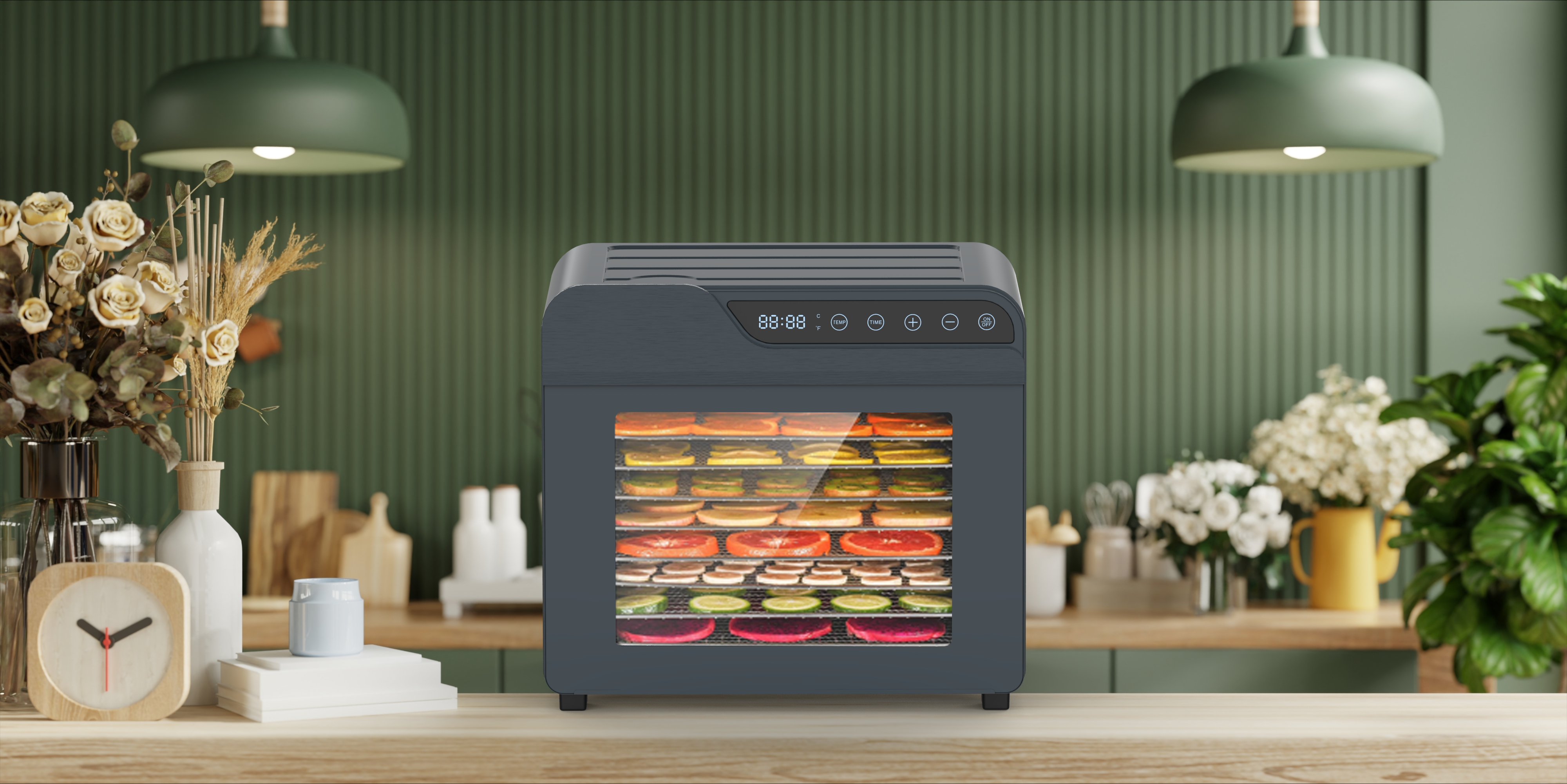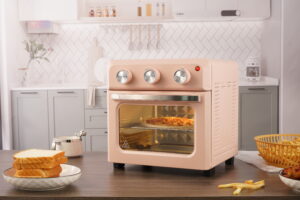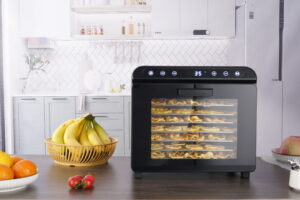As the Sales Manager at Foshan Linden Intelligent Appliances Co., Ltd., I love helping home cooks preserve their favorite fruits with ease and efficiency. From our factory in China, we produce top-quality food dehydrators, alongside our 12L, 16L, and 30L air fryer ovens and air fryers, exported to North America, Europe, Russia, and the Middle East. A common question I hear at trade shows and through our website, lindensmart.com, is: How do I choose the right food dehydrator for home use? I’m excited to share my expertise and guide you through selecting the best dehydrator for drying fruits at home.
In this article, I’ll compare different types of food dehydrators, focusing on their features, performance, and suitability for fruit preservation. Drawing from our experience at Linden, where we design innovative appliances with customizable settings, I’ll outline key factors to help you make an informed choice. Let’s dive into the world of fruit drying and find your perfect dehydrator!
What Are Food Dehydrators?
Food dehydrators are countertop appliances that remove moisture from fruits, vegetables, herbs, and more. They use a heating element and fan to circulate warm air, preserving food for long-term storage. According to WebMD, dehydrated fruits retain most vitamins and minerals, making them a healthy snack option. Choosing the right dehydrator depends on your drying needs, kitchen space, and budget.
Why Choose a Food Dehydrator?
I’ve seen home cooks embrace dehydrators for their ability to reduce food waste and create shelf-stable snacks. Whether you’re drying apples from your garden or mangoes from the market, the right dehydrator makes the process simple and rewarding.
Types of Food Dehydrators
Food dehydrators come in two main types: horizontal and vertical. Each has unique features that impact fruit drying performance. Let’s explore these to help you decide.
Key Factors in Choosing a Food Dehydrator
Selecting the best food dehydrator involves evaluating several factors. Here’s what to consider when drying fruits at home.
Airflow Design
Horizontal Airflow Dehydrators
Our Linden food dehydrators use horizontal airflow, with a fan at the back blowing air across trays. This ensures even drying, eliminating the need to rotate trays. Consumer Reports highlights that horizontal airflow provides consistent results, making it ideal for fruits like strawberries or bananas.
Vertical Airflow Dehydrators
Vertical dehydrators have a fan at the top or bottom, pushing air through stacked trays. Drying can be uneven, requiring tray rotation to ensure all fruit dries properly. This makes them less convenient for large batches.
Capacity and Tray Size
Large-Capacity Dehydrators
Our food dehydrators feature spacious, rectangular trays, perfect for drying large quantities of fruit. For example, you can dry multiple trays of apple slices or peaches at once, ideal for families or frequent users. Larger capacity reduces the need for multiple drying sessions.
Compact Dehydrators
Vertical dehydrators often have smaller, round trays, limiting capacity. They’re suitable for small households or occasional drying but may require more cycles for bulk harvests, which can be less efficient.
Temperature Control
Adjustable Temperature Settings
Our food dehydrators offer adjustable temperatures (90–165°F), allowing precise control for different fruits. For instance, delicate berries dry best at 130°F, while apples may need 140°F, per Healthline. Precise settings ensure optimal drying without nutrient loss.
Fixed Temperature Models
Some dehydrators have fixed or limited temperature settings. These may not suit all fruits, potentially over-drying delicate items or under-drying heartier ones, affecting quality and efficiency.
Wattage and Energy Efficiency
Mid-Wattage Dehydrators (400–600W)
Our Linden dehydrators use 400–600W, consuming 0.4–0.6 kWh per hour, per Energy Star. They balance power and efficiency, drying fruits like mangoes in 6–8 hours while keeping energy costs low.
Low-Wattage Dehydrators (200–400W)
Low-wattage models use less power but take longer (8–12 hours), which may offset energy savings. They’re best for small batches or occasional use.
High-Wattage Dehydrators (600–1000W+)
High-wattage models dry faster but use more energy (0.6–1 kWh per hour). They’re suited for heavy users but less energy-efficient for home fruit drying.
Build Quality and Durability
Durable Materials
Our dehydrators use food-safe, durable materials that withstand frequent use. Good insulation retains heat, improving efficiency and longevity. This ensures consistent performance for years.
Basic Builds
Lower-cost models may use less durable materials, leading to wear over time. This can affect drying consistency and increase energy use as insulation degrades.
Ease of Use
User-Friendly Features
Our food dehydrators have digital controls, timers, and preset modes, making fruit drying simple. You can set it and forget it, checking only when the timer signals completion. This is perfect for busy home cooks.
Manual Controls
Basic dehydrators with manual dials may require more monitoring. This can be less convenient, especially for beginners or those drying large quantities of fruit.
Comparing Types of Food Dehydrators
Let’s compare different food dehydrators to find the best for home fruit drying.
Linden’s Horizontal Food Dehydrators
Our horizontal food dehydrators are designed for performance and convenience. The even airflow ensures consistent drying without tray rotation. With adjustable temperatures and spacious trays, they’re ideal for drying fruits like apples, bananas, or berries in 6–8 hours. Their mid-wattage design balances speed and energy efficiency, making them a top choice for most homes.
Key Benefits
- Even Drying: Horizontal airflow for uniform results.
- Large Capacity: Spacious trays for bulk drying.
- Energy Efficiency: Uses 0.4–0.6 kWh per hour.
- User-Friendly: Digital controls and timers for ease.
Vertical Food Dehydrators
Vertical dehydrators are compact and often more affordable. They use stackable trays, making them suitable for small kitchens. However, uneven airflow may require tray rotation, and smaller trays limit capacity. They’re best for occasional drying of small fruit batches, like a single tray of strawberries.
Key Benefits and Drawbacks
- Benefits: Compact, budget-friendly, low-wattage options.
- Drawbacks: Uneven drying, smaller capacity, more hands-on.
High-Capacity, High-Wattage Dehydrators
High-wattage dehydrators are powerful and fast, drying fruits in 4–6 hours. They often feature large trays and robust builds, suitable for avid preservers. However, their higher energy consumption makes them less ideal for most home users unless drying large volumes regularly.
Key Benefits and Drawbacks
- Benefits: Fast drying, high capacity.
- Drawbacks: Higher energy use, larger footprint.
Practical Applications for Home Fruit Drying
Different dehydrators suit various fruit-drying scenarios. Here’s how they perform based on your needs.
Occasional Fruit Drying: Vertical Dehydrators
For small batches, like drying a few trays of berries, vertical dehydrators are practical. Their compact size and low cost make them ideal for beginners or small households. However, you may need to rotate trays for even results.
Frequent or Bulk Drying: Linden’s Horizontal Dehydrators
Our food dehydrators excel for frequent or bulk fruit drying. Their large trays and even airflow handle multiple batches of apples, peaches, or mangoes efficiently. They’re perfect for families, gardeners, or anyone preserving seasonal harvests.
Heavy-Duty Drying: High-Wattage Models
For those drying large quantities regularly, high-wattage dehydrators offer speed and capacity. They’re less common for home use but suit avid preservers or small businesses.
Health Benefits of Dehydrated Fruits
I’m passionate about healthy eating. Dehydrated fruits retain most nutrients, per WebMD. They’re perfect for snacks, baking, or trail mixes, offering a preservative-free, nutrient-rich option. Choosing the right dehydrator ensures you maximize these benefits.
Environmental Impact
Energy-efficient dehydrators align with sustainable living. Our models use less power and produce shelf-stable fruits, eliminating the need for energy-intensive refrigeration, unlike freezing. This reduces your carbon footprint, per Energy Star.
Which Food Dehydrator Is Best for You?
Choosing the right food dehydrator depends on your fruit-drying needs. Here’s how to decide, based on my experience with buyers.
Choose Our Linden Food Dehydrators If You:
- Dry medium to large batches of fruit regularly.
- Want consistent results without tray rotation.
- Need precise temperature control for various fruits.
- Value durability and energy efficiency.
- Seek user-friendly features like digital controls.
Our horizontal dehydrators are perfect for most home cooks, offering performance and convenience.
Choose Vertical Dehydrators If You:
- Dry small batches occasionally.
- Have limited kitchen space or budget.
- Don’t mind rotating trays for even drying.
- Prefer a compact, affordable option.
Choose High-Wattage Dehydrators If You:
- Dry large volumes frequently.
- Need fast drying for bulk preservation.
- Can accommodate a larger appliance and higher energy use.
Quality and Certifications
At Linden, quality is our priority. Our food dehydrators meet UL and CE standards, ensuring safety and durability. Their robust design delivers reliable performance, making them a trusted choice for fruit drying.
Logistics and Customer Support
From my experience with global buyers, logistics matter. Our food dehydrators are lightweight and easy to ship, ensuring timely delivery worldwide. We streamline production to meet tight schedules. Need help? I’m here at sales4@fslinden.com to assist.
SEO-Friendly Tips for Choosing a Food Dehydrator
To select the best food dehydrator for fruit drying, here are tips optimized for search terms like “best food dehydrators for home use” or “fruit drying appliances”:
- Assess Capacity Needs: Match tray size to your drying volume.
- Prioritize Airflow: Choose horizontal models for even drying.
- Check Temperature Controls: Ensure adjustable settings for fruits.
- Read Reviews: Explore platforms like CNET for insights.
- Test at Trade Shows: Try appliances hands-on for confidence.
Final Thoughts: The Best Food Dehydrator for Fruit Drying
As someone who loves helping home cooks preserve fruits, I believe our Linden food dehydrators are the best choice for most households. Their horizontal airflow, spacious trays, and precise controls make drying fruits easy, efficient, and consistent. Vertical dehydrators suit small-scale drying, while high-wattage models are best for bulk needs but use more energy. Your choice depends on your drying frequency, kitchen space, and goals.
Ready to start drying fruits? Visit lindensmart.com to explore our food dehydrators, or email me at sales4@fslinden.com for personalized advice. Let’s make your fruit preservation simple and delicious!
Meta Title: Best Food Dehydrators for Home Fruit Drying
Meta Description: Compare food dehydrators for home fruit drying. Find the best model for capacity, efficiency, and ease of use.




